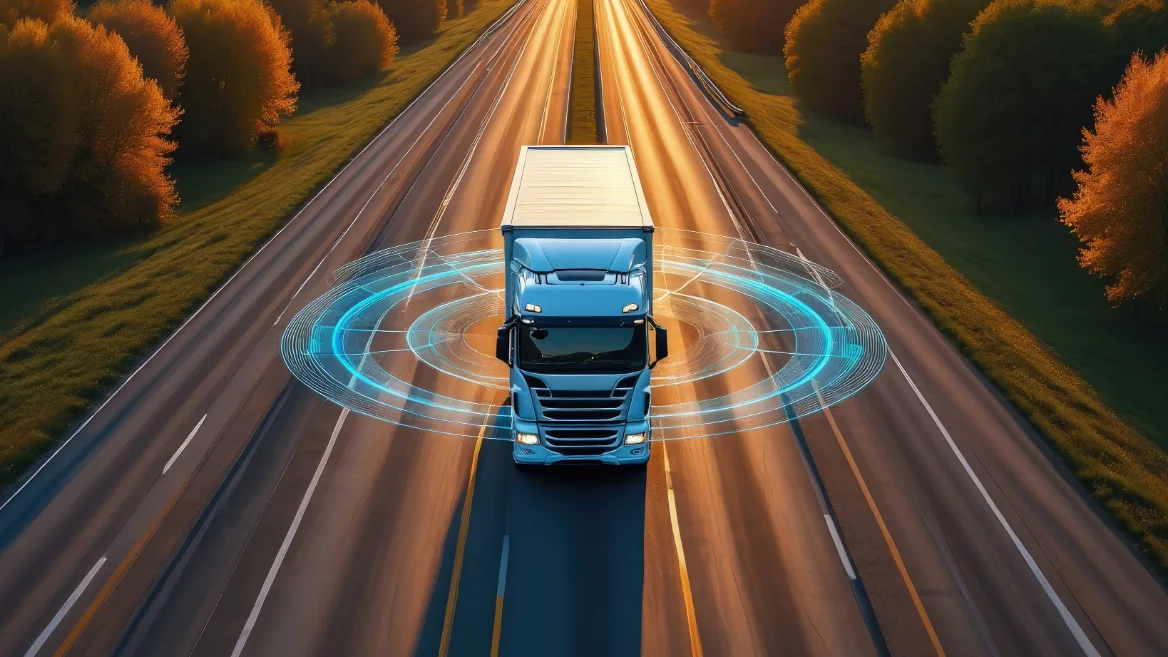Modern ADAS systems are transforming how drivers and fleet operators manage safety on the road. Once seen as optional extras, these technologies are fast becoming standard in heavy goods vehicles.
For an industry where safety, efficiency, and reliability matter, advanced driver assistance systems are changing the way we drive, manage, and maintain fleets.
What we’ll cover
Fleets, bookings, subcontractors, compliance & payments.
With HX, you can manage them all in one place.
What is ADAS?
ADAS technology combines sensors, cameras, radar, and onboard software to monitor surroundings and support drivers in real time. It doesn’t replace human judgement, but it provides an extra layer of awareness that helps prevent accidents and improve comfort on long routes.
Here’s a quick look at how the main features work:
| ADAS Feature | What It Does | Why It Matters for HGVs |
|---|---|---|
| Adaptive cruise control (ACC) | Adjusts speed to maintain a safe distance | Reduces fatigue and rear-end collisions |
| Lane departure warning (LDW) | Alerts the driver if the truck drifts | Helps avoid lane drift and side swipes |
| Automatic emergency braking (AEB) | Brakes automatically if a collision is likely | Prevents or reduces crash severity |
| Blind spot detection (BSD) | Monitors blind spots using radar or cameras | Reduces risk during lane changes |
| Driver fatigue monitoring | Detects drowsiness or distraction | Warns drivers to take a break |
These systems use the same foundation as ADAS calibration tools, which align sensors and cameras to maintain accuracy. Together, they create an integrated safety net that benefits both drivers and operators.
How ADAS improves safety and efficiency
Every HGV driver knows how demanding long-distance driving can be. Fatigue, limited visibility, and unpredictable road users all raise the chance of an accident. ADAS technology supports safer driving by spotting hazards sooner than the human eye.
Automatic braking, adaptive cruise control, and lane assistance all help reduce reaction times. In practice, this means fewer rear-end collisions and side impacts. Many fleet operators also report lower fuel use thanks to smoother acceleration and fewer hard-brake events.
For drivers, this technology makes long routes less tiring. Alerts for lane drift or fatigue reduce pressure, especially during overnight deliveries or when handling high-risk freight. The result is a safer and calmer driving experience.
ADAS for fleet managers
For fleet managers, the benefits go beyond road safety.
Connected ADAS systems provide real-time data that can help with maintenance schedules, HGV insurance reporting, and compliance checks.
| Benefit | Impact |
|---|---|
| Fewer accidents | Reduced repair costs and downtime |
| Telematics integration | Better visibility and data accuracy |
| Lower maintenance | Less strain on tyres and brakes |
| Improved compliance | Supports GSR2 safety standards and DVSA fleet inspections |
| Training support | Identifies where drivers may need more guidance |
Integrating ADAS systems into your wider yard management systems also improves coordination. When vehicles communicate status updates automatically, your dispatchers can plan around issues faster and avoid complications with your contracts.
The importance of ADAS calibration
ADAS calibration keeps the system working properly after repairs, windscreen replacements, or wheel alignments. Calibration means adjusting cameras, sensors, and radar units so that they can read distances and surroundings accurately.
If calibration is off, even by a small margin, the system may misjudge obstacles or fail to trigger a warning in time. That’s why it’s recommended to include calibration checks in regular HGV maintenance.
Correct calibration also supports compliance with UK and EU tachograph rules, since the data from ADAS sensors often integrates with digital reporting systems. Keeping those aligned means more accurate logs, better safety checks, and fewer problems during fleet inspections.
Challenges and misconceptions
Despite the benefits, adoption across the haulage industry still varies. Smaller operators may see ADAS as expensive to install or maintain, especially for older haulage vehicles.
Yet, the cost of an accident or extended downtime often outweighs the upfront investment.
Training is another hurdle. Drivers need time to understand how different alerts and interventions work. That’s where driver CPC training can help by introducing ADAS use into safety modules.
There’s also a concern about over-reliance on the system. Drivers must stay alert and remember that ADAS assists rather than replaces their attention. The most effective fleets combine technology with driver awareness, not one without the other.
Regulations and the future of HGV safety
European and UK safety standards are pushing the industry forward. Under the EU’s General Safety Regulation (GSR2), several ADAS systems—including lane keeping and automatic braking—are now mandatory on new vehicles. The UK has adopted similar standards, creating consistency for international fleets.
This move aligns with wider efforts to reduce collisions involving longer heavier vehicles (LHVs) and improve overall freight safety. For operators, compliance isn’t just about ticking boxes. It’s about staying ahead as the transport sector evolves toward automation and smarter logistics.
In the near future, we’ll see more connected ADAS technology that links vehicles, depots, and infrastructure. Combined with secure truck parking and live telematics, it’ll allow safer rest planning and better use of periods of availability.
These changes will support sustainability targets too, by cutting idle time and improving routing efficiency.
ADAS and the bigger picture
The development of ADAS systems sits at the heart of the shift toward autonomous driving. But it’s not about removing drivers from the cab. It’s about giving them better tools to make informed, confident decisions.
Safer fleets mean fewer accidents, reduced downtime, and better delivery reliability. For an operator, that also improves the business case when competing for haulage contracts.
For the wider sector, ADAS could play a major role in tackling issues like driver shortages, insurance costs, and HGV speed restrictions. Every alert, sensor, and automated assist helps keep drivers safer, freight more secure, and roads less congested.
Final thoughts
Modern ADAS technology is reshaping how HGV fleets operate. For drivers, it brings safety, comfort, and confidence on the road. For fleet managers, it offers valuable insight into performance, compliance, and efficiency.
The future of haulage isn’t autonomous—it’s assisted. Systems that detect, alert, and support drivers are the next step in building smarter, safer logistics networks.
As adoption grows, those who invest early will not only reduce accidents but also gain a strong advantage in both safety standards and customer trust.
Frequently asked questions
What does ADAS mean on a truck?
ADAS stands for Advanced Driver Assistance Systems. It refers to electronic safety features such as adaptive cruise control, lane departure warnings, and automatic braking that help drivers avoid accidents.
Do all HGVs need ADAS?
Not yet, but most new models include it as standard. UK and EU safety regulations are gradually making ADAS features mandatory on new HGVs.
How often should ADAS calibration be done?
You should calibrate sensors whenever the windscreen, wheels, or bumpers are replaced, or after any accident. Regular checks are also recommended as part of standard maintenance.
Can ADAS reduce insurance costs?
Yes. Many insurers offer discounts for vehicles equipped with ADAS because they lower accident rates and repair costs.
Is ADAS the same as autonomous driving?
No. ADAS supports the driver but doesn’t replace them. It provides alerts and automatic responses to improve safety while keeping the driver in full control.




